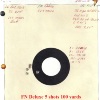I am leery of small sample sizes.I used to shoot ten shot groups on initial testing, now I am getting lazy and testing five shot groups, typically increasing charges by 1/2 grain. If the load is bad, it is usually bad all the way through the sequence. Then, if the load has promise, shoot ten shot groups, sometimes 20 shot groups.
Then go to CMP Talladega and shoot at 200, 300, sometimes 600 yards. You would think that would solve everything, but, often I experience leaking or blown primers, which then cause me to cut the loads.
Shot well expect for the blown primers and the bolt face etch.

And you know, testing the reduced loads, I find they were not so bad after all.
It really takes lots of rounds downrange to have confidence in your ammunition.
Then go to CMP Talladega and shoot at 200, 300, sometimes 600 yards. You would think that would solve everything, but, often I experience leaking or blown primers, which then cause me to cut the loads.
Shot well expect for the blown primers and the bolt face etch.

And you know, testing the reduced loads, I find they were not so bad after all.
It really takes lots of rounds downrange to have confidence in your ammunition.









